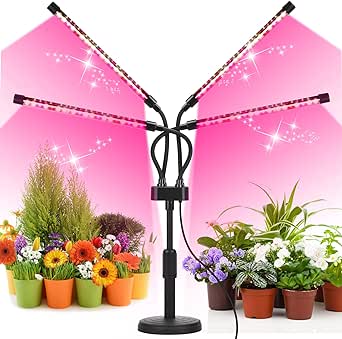Growing plants indoors can be a rewarding and enjoyable hobby, but it requires providing the right conditions for your plants to thrive. One essential element is adequate lighting, which can be challenging to achieve in indoor settings. This is where grow lights come in handy. Grow lights are artificial light sources designed to mimic the spectrum of natural sunlight, providing the necessary wavelengths for plant growth and development. In this comprehensive guide, we’ll explore the key factors to consider when choosing the best grow lights for your indoor plants.

Types of Grow Lights
There are several types of grow lights available on the market, each with its own advantages and disadvantages. Understanding the different types can help you make an informed decision based on your specific needs and preferences.
LED Grow Lights: LED (Light-Emitting Diode) grow lights are becoming increasingly popular due to their energy efficiency, long lifespan, and ability to emit specific wavelengths of light that are beneficial for plant growth. They are available in various configurations, such as single-head or multi-head designs, and can be adjusted to provide the optimal light intensity and spectrum for different stages of plant growth.
Fluorescent Grow Lights: Fluorescent grow lights are a more traditional option that provides a broad spectrum of light suitable for various plant types. They are relatively inexpensive and energy-efficient, making them a good choice for beginners or small-scale indoor gardening.
HID (High-Intensity Discharge) Grow Lights: HID grow lights, including High-Pressure Sodium (HPS) and Metal Halide (MH) lamps, are known for their high light output and are often used in large-scale indoor growing operations. However, they can be more expensive to operate and generate more heat compared to other types of grow lights.
Factors to Consider When Choosing Grow Lights
When selecting grow lights for your indoor plants, consider the following factors:
Light Spectrum: Different plants require different wavelengths of light for optimal growth. Look for grow lights that provide a full spectrum of light, including blue and red wavelengths, which are essential for plant growth and development.
Light Intensity: The intensity of light is measured in lumens or PAR (Photosynthetically Active Radiation) values. Different plants have varying light requirements, so choose grow lights with an appropriate intensity for your specific plants.
Coverage Area: Consider the size of your growing space and choose grow lights with a coverage area that matches your needs. Multi-head grow lights, such as the SYEIORAOM Grow Lights for Indoor Plants with four or six heads, can provide a larger coverage area and allow for more flexibility in positioning the lights.
Adjustability: Look for grow lights with adjustable features, such as gooseneck arms or telescopic poles, which allow you to easily adjust the distance between the light and your plants. This feature is particularly useful for accommodating plants of different heights or for providing the optimal light intensity at different stages of growth.
Energy Efficiency: Choose energy-efficient grow lights to save on your electricity bills and reduce your environmental impact. LED grow lights are generally the most energy-efficient option, providing high light output while consuming less power.
Setting Up and Using Grow Lights
Once you have chosen the best grow lights for your indoor plants, follow these tips for setting them up and using them effectively:
Positioning: Place your grow lights at the appropriate distance from your plants, following the manufacturer’s recommendations. Adjust the height as your plants grow to maintain the optimal light intensity.
Timing: Provide your plants with the right amount of light each day, typically 12-18 hours for most indoor plants. Use a timer to ensure consistent lighting schedules.
Ventilation: Grow lights can generate heat, so ensure adequate ventilation in your growing space to prevent overheating and maintain a comfortable temperature for your plants.
Monitoring: Keep an eye on your plants and adjust the lighting as needed. Signs of too much or too little light include stretching, discoloration, or stunted growth.
By considering these factors and following best practices for setting up and using grow lights, you can create an optimal growing environment for your indoor plants, ensuring their health and vitality.